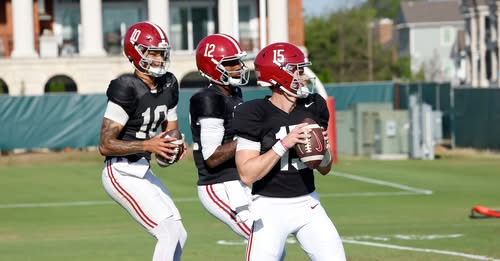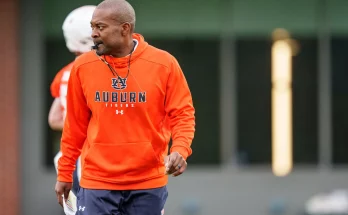Alabama Names Ty Simpson Starting QB for Season Opener vs. Florida State—Backup Battle Now in Spotlight
The quarterback question at Alabama has finally received its answer—at least the first half of it. On Monday, head coach Kalen DeBoer named Ty Simpson as the Crimson Tide’s starting quarterback for the highly anticipated 2025 season opener against Florida State on August 30. The decision brings clarity at the top of the depth chart after months of speculation, competition, and film room analysis. But while the announcement solidifies who will lead Alabama’s offense onto the field in Atlanta, it also raises another pressing question: who will back him up?
The race for the primary backup quarterback role is now front and center in Tuscaloosa. With the spotlight fixed on Simpson’s ascension, the attention behind him has only intensified. DeBoer has remained publicly noncommittal about naming a clear No. 2 just yet, emphasizing that competition will continue deep into fall camp. But make no mistake—the battle is critical. In today’s college football landscape, where quarterback injuries, in-game substitutions, and mid-season shifts are common, a team’s second-string quarterback must be nearly as prepared and polished as the starter. For a program like Alabama, which has national title aspirations every single year, the backup quarterback isn’t just insurance—it’s a necessity.
Ty Simpson’s journey to the starting job has been one of steady growth, perseverance, and undeniable talent. A former five-star recruit out of Tennessee, Simpson waited patiently behind Jalen Milroe and others, developed under multiple offensive coordinators, and weathered coaching transitions. Now under Kalen DeBoer and offensive coordinator Nick Sheridan, Simpson has finally earned his opportunity to lead. His combination of arm strength, mobility, and cerebral command of the offense reportedly gave him the edge during spring practices and early fall camp sessions. According to sources close to the program, Simpson’s consistency in decision-making and ability to stretch the field made him the clear choice heading into a marquee matchup with Florida State.
Yet behind Simpson, the room remains crowded with potential and uncertainty. Chief among the contenders for the backup role is Dylan Lonergan, the redshirt freshman who has impressed coaches and teammates with his natural arm talent and poise beyond his years. Lonergan, a dual-sport athlete who also excelled in baseball, possesses the kind of athleticism and field vision that make him a viable option should his number be called. He performed well during the spring game and has reportedly made significant strides in his understanding of the playbook during summer workouts. While still young, his upside is immense, and his competitive fire makes him a serious candidate for the QB2 spot.
Also firmly in the mix is Austin Mack, a high-ceiling early enrollee who turned heads upon arrival with his maturity and raw ability. Though still adapting to the college game, Mack has shown flashes of brilliance during practices, displaying a quick release, pocket awareness, and a willingness to push the ball downfield. Coaches have been cautiously optimistic about his progress, and while it might be early to thrust him into the backup role, his trajectory suggests he’ll be in the conversation all season long. The question is whether he can learn fast enough to be trusted in high-pressure moments against elite defenses.
Then there’s the possibility of a dark horse emerging. Alabama has been known to rotate quarterbacks in unique packages or leverage situational strengths. Depending on how the offensive staff wants to shape the game plan week to week, there may be scenarios in which the backup role isn’t held by a single player but shared depending on game flow and opponent. While this approach introduces more complexity, it could also keep defenses guessing and provide valuable in-game reps for multiple young quarterbacks. However, in a system like DeBoer’s—which values rhythm, timing, and quarterback chemistry with receivers—the staff may ultimately prefer a more stable QB2 presence.
The decision on who backs up Simpson isn’t just about talent. It’s about trust. Coaches need to know that the player stepping into the huddle, even in emergency situations, can manage the offense, protect the football, and keep the team moving forward. That means pre-snap recognition, composure under pressure, and the ability to communicate clearly in fast-moving situations. While physical tools are essential, intangibles may prove to be the deciding factor. With that in mind, the remainder of fall camp takes on added weight. Every rep, every drill, and every scrimmage snap will be evaluated under the microscope.
In recent years, Alabama has witnessed firsthand how quickly backup quarterbacks can become the face of the program. From Tua Tagovailoa’s legendary relief appearance in the national championship game to Mac Jones rising from second string to first-round pick, history has shown that the next man up must always be ready. That history casts a long shadow in this current battle. The player who earns the backup role may not see meaningful snaps in Week 1, but the odds say his time will come—and it could shape the course of Alabama’s season.
DeBoer and his staff are also aware of the broader implications. In the modern NIL and transfer portal era, quarterback management is more delicate than ever. Promising young players want opportunities. Development matters, but so does playing time. How the staff handles reps, depth chart transparency, and communication will have long-term ripple effects on retention and recruitment. With multiple talented quarterbacks on the roster and more on the way in future classes, ensuring each feels valued and properly developed is a challenge that goes beyond on-field decisions.
For Ty Simpson, Monday’s announcement is the realization of years of effort. He now steps into one of the most scrutinized roles in all of sports—Alabama’s starting quarterback. The pressure is immense, the spotlight unrelenting, and the expectations sky-high. But with the trust of his coaches and teammates, and the tools he’s sharpened during his developmental years, he now has the opportunity to write his own chapter in the program’s storied quarterback lineage. His play will be dissected weekly, but it’s the strength of the room behind him that will help define the overall stability of Alabama’s offense this season.
With just weeks remaining before the clash against Florida State, the backup battle promises to be one of the most closely watched storylines in Tuscaloosa. DeBoer has hinted that a decision could come shortly after the team’s second fall scrimmage, but he’s also left the door open for continued competition well into the season. For now, the message is clear—every quarterback not named Ty Simpson is still in the fight. Every practice matters. Every mistake and every spark of brilliance could be the difference between clipboard and clutch moment.
As Alabama looks to open the season against one of the most complete teams in the country in Florida State, the need for clarity behind center becomes even more critical. The Seminoles will test the Tide’s offensive line, disguise coverages, and force the quarterback to make quick, decisive plays. While the coaching staff is confident in Simpson’s readiness, they’re well aware that having a fully prepared backup could mean the difference between championship dreams and midseason derailment.
The Crimson Tide may have found their starter, but the full story of Alabama’s quarterback room is still unfolding. In the coming weeks, the answer to who will stand directly behind Ty Simpson—ready to lead, ready to deliver—will finally emerge. Until then, the competition remains fierce, the pressure high, and the stakes nothing short of championship-level. The quarterback battle isn’t over. In fact, it may just be entering its most important phase yet.



